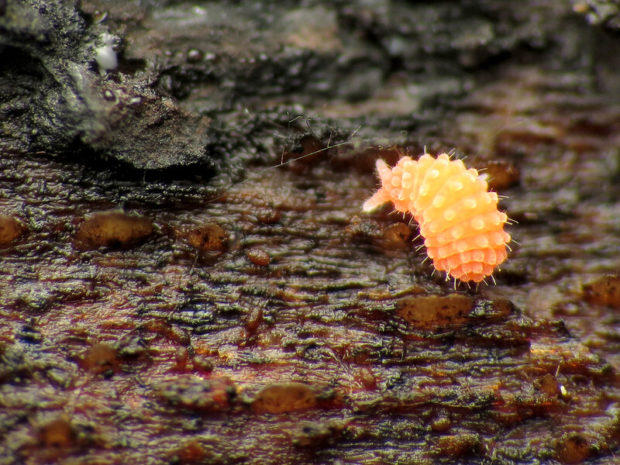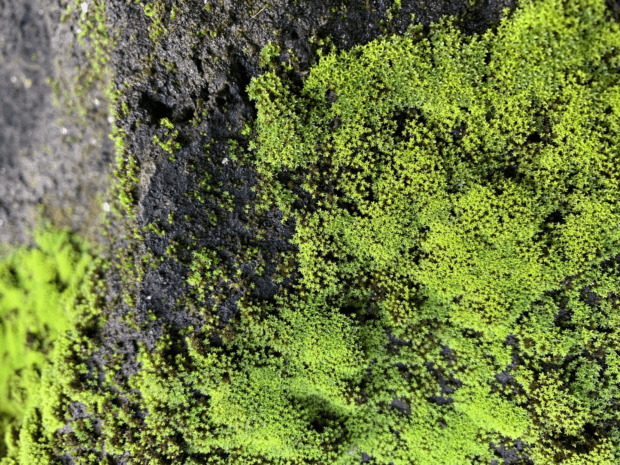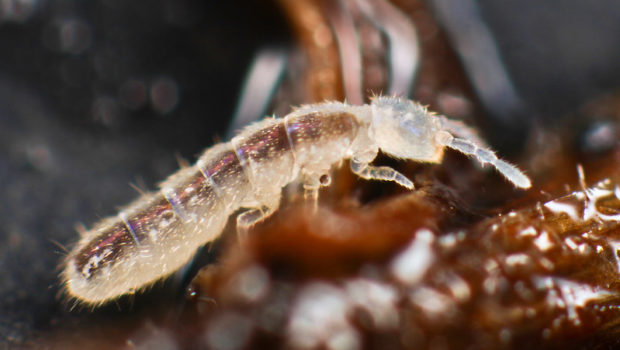We have much more to do and your continued support is needed now more than ever.
In Celebration of the Springtail
The gardens we grow to support birds, bees, and other wildlife would not flourish without a little help from the soil food web. A handful of soil is teeming with tiny animals and microbes that shred, grind, and digest the organic matter that feeds our plants. Among these tiny creatures is the enigmatic springtail.
In graduate school, I was love-struck by this tiny creature that called my study model — moss — home. I was reminded of this love the other day while working in my garden when I noticed a familiar form somersaulting in the atmosphere just above my sedums. Springtails are insect-like creatures that are small yet impactful in many ecosystems. Mere millimeters in length, these animals are often overlooked but have a rich ecology and biology.
Some amazing things about springtails
- Their common name comes from the unique way they propel themselves in the air when startled using a specialized structure called a “furcula”. This structure acts much like a loaded spring, launching some springtail species to heights many times their body size. However, despite the shared name, not all springtails jump or possess a furcula.
- Springtails come in all shapes and sizes, the spectacular diversity of which has been celebrated by macro photographers and delighted me in graduate school. Springtail body shapes range from narrow and elongated, to squat and hunched. The plumpness of some species reminds me a little of a gummy bear.

Image by Katja Schulz (Flickr, CC BY 2.0)
- Springtails are consumers of fungi, microbes, decaying plant matter, and micro-fauna. They help with fungal dispersal, keep plant pests in check, and help break down dead organic matter so other soil critters can eat too.
- Springtails are able to detect ideal food sources by smell. Studies have demonstrated that springtails facilitate moss reproduction and are attracted to the fragrances coming from moss, much like a bee to a flower.
- Springtails are everywhere; even in Antarctica! In some environments, there can be as many as 12,000 springtails per square foot of soil. Springtails prefer moist environments and can be found on fungi, in soil, leaflitter, tree canopies, moss, and even on snow. One day, I found purple springtails clambering on clumps of moss growing on my exposed and dilapidated garage roof!

Image by Caitlin Maraist.
- Springtails are typically no longer than 3 mm (grab your ruler for a size comparison). The largest springtail, a forest dweller found only in New Zealand, can reach a whopping length of 8 mm!

Image by Andy Murray (Flickr, CC BY-SA 2.0)
- Springtails are used in soil-quality tests because they are easy to raise and observe in the lab. A decline in their reproduction is a sure-fire indicator of a chemical’s toxicity to springtails. Excessive use of chemical fertilizers and pesticides can have a negative effect on beneficial soil organisms like the springtail.

Image by Andy Murray (Flickr, CC BY-SA 2.0)
- Some springtails are only female, reproducing through a clonal process called parthenogenesis (par-theh-no-genesis) that may be caused by a bacterium that resides within their cells.
Springtails are a beneficial component of a well-functioning soil ecosystem because they feed on microorganisms that might cause plant disease and help breakdown organic matter. Gardeners can support the diversity of springtails, and other beneficial soil fauna, in their greenspaces by leaving behind leaf litter and woody debris, limiting soil disturbance, avoiding chemical fertilizers and pesticides, and safely applying compost. You can find more information about improving the health of your garden soils.
And next time you’re in the garden, take a long and appreciative look at your soil. You might just catch a glimpse of a springtail pirouetting through the air.





















